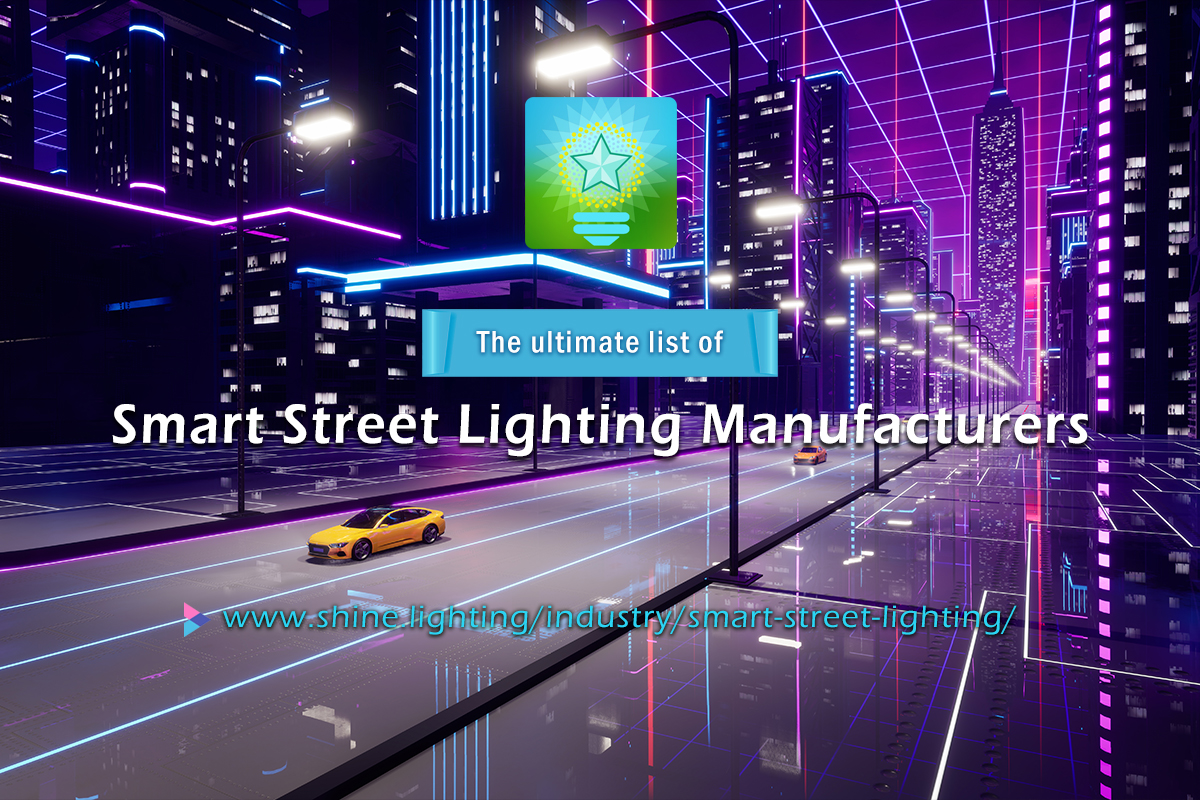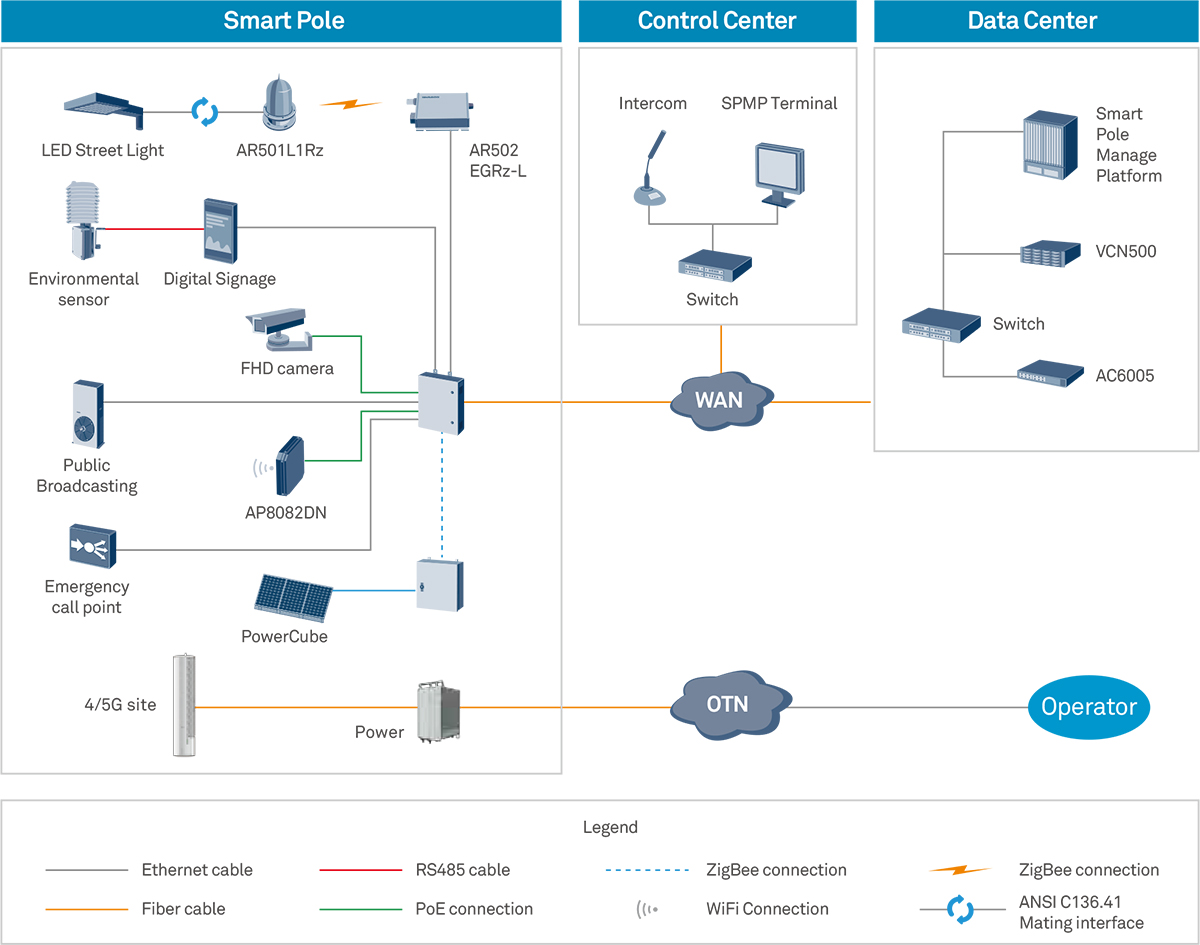Table of Contents Hide

As an integral part of urban infrastructure, street lighting contributes to the safety and security of road traffic. The sheer number of lights required for full coverage of the road system creates a strong need for lighting solutions that are as economical as possible, yet simultaneously provide an enhanced visual environment allowing accurate and comfortable visibility during hours of darkness. This in turn facilitated the development of intelligent lighting controls and energy management systems that enable the light fixtures to operate autonomously using various prediction algorithms based on astrological calendar, photocontrols or motion detectors. Implementing intelligent street lighting with a central management system (CMS) via wireless and wired networks rounds out a portfolio of capabilities that save energy and improve the quality of lighting.
LED Street Lighting
The lighting industry has been going through a radical transformation fueled by the technological advances in solid state lighting (SSL) based on light emitting diode (LED) technology. An LED converts electrical energy into light energy through the radiative recombination of electrons and holes released from oppositely doped semiconductor compound layers. The semiconductor device exhibits a high wall plug efficiency and comes with a long operating life. Operating in the solid state rather than by exciting a gaseous medium or heating a filament, LEDs bring rugged durability to street lighting systems which undergoes repetitive vibrations in roadway applications. All of these features translate to considerable savings in energy and maintenance costs with LED street lighting and therefore a significantly better return on investment over traditional lighting systems.In contrast to traditional light sources (e.g. fluorescent and HID) that present a number of challenges with regarding to lighting controls, LEDs are current driven devices that react instantaneously to changes in power input. This unique attribute allows smooth dimming profiles to be created and dynamic lighting scenes to be programmed in LED street lights. The semiconductor nature of LEDs drives the digital transformation of street lighting. The ability of LEDs to be seamlessly controlled by electronic logic circuits or processors opens the door to a wide range of interactive capabilities that bridge the gap between the digital and physical world.
Light Management
At the most basic level, street lights are networked and addressed in groups or individually to allow for remote configuration, control and monitoring. The networked control system typically consists of a CMS (sometimes referred to as a management station), one or more gateways, controllers, as well as other terminal devices. The CMS is a centralized platform that runs in the cloud or on an on-premises server. Such a conventional street lighting CMS collects and stores streetlight data using a data logger. A graphical user interface (GUI) is created by the web-based user application to assist in the remote control, configuration and monitoring of street lights.The street light controller is designed to originate commands to control the LED driver and hence the operation of the LEDs based on a control model and sensor feedbacks. Conventional controllers are configured to implement a pre-programmed behavior or mode of operation. The controller will switch on/off the lights or adjust the intensity of the light output according to user-defined settings, thereby maximizing the efficiency of a single piece of equipment. A controller may be implemented either using a simple control circuit that acts on sensor inputs or a processor consisting of one or more programmed microprocessors and associated circuitry. The controller is installed inside the pole or inside the luminaire.
In case a street light is not capable of directly connecting to the CMS, a gateway can forward communication between the CMS and the light. The gateway is equipped with technologies and mechanisms required to translate information between different protocols, such as BACnet to DALI, or DMX512 to 0-10 VDC. A gateway can communicate with multiple streetlight controllers and may implement edge intelligence capabilities. The gateway can include, for example, a protocol translator, a real-time clock, a transceiver, a memory, an Ethernet port, a fault isolator, etc.
The terminal devices can be sensors which sense certain characteristics of their surroundings and pass them on to the street light controller. The terminal devices can also be electronic circuits that interact with the controller with pre-programmed sequences. A photocell is usually integrated into an outdoor lighting system to provide dusk-to-dawn photocontrol. Motion sensors such as passive infrared (PIR) sensors, microwave sensors and ultrasonic sensors can be used to change the state of a light when motion is detected. Sensors provide on-demand lighting, whereas time switches and astronomical clocks allow lighting control with a predefined schedule. Terminal devices are mounted on luminaires or street light poles. They can operate as a standalone solution or can be used in conjunction with a networked system.
The remote connectivity of conventional street light management systems are provided by wired or wireless communication networks, including Ethernet, power line carrier (PLC), 2G/3G/4G cellular networks, and proprietary RF systems. In general, the limited amount of applications and controls place little demand on the communication network. Network reliability and low cost operation therefore take precedence in evaluating a communication technology.
Intelligent Street Lighting
The idea of adding controls and connectivity to street lights was originally driven by the need to automate basic lighting controls such as switching on/off and dimming, and to enable data recording and logging of operational parameters and abnormal conditions. A growing trend towards leveraging intelligence and networking to wring inefficiencies out of operations has facilitated more sophisticated lighting control algorithms and increased networking of street lights. Advanced light management allows city managers to automate critical but time-consuming tasks, unlock new operational insights, enable more adaptive lighting and generate significant cost savings. Wireless connectivity technologies are evolving to address the scalability and interoperability requirement for handling a large number of geographically scattered streetlights.Intelligent street lighting systems provide sophisticated user interactivity and advanced dimming and scheduling functions. The integration of controls, sensors and connectivity allows intelligent street lights to form a self-adaptive distributed network that acclimatizes street lighting to the changing conditions on the road. The light controller can be programmed to operate the street light in different modes according to traffic, time and environmental factors. The wireless radio module of the controller typically operates in a mesh network. The mesh network topology provides high levels of reliability by enabling each lighting node to communicate with its neighbor and thus providing more than one path through the network for any wireless link.
On-demand adaptive lighting is enabled by a sensor module will only react to human activity, e.g. to pedestrians, cyclists and cars. Other sensor devices are employed to sense and measure environmental variables and system conditions. A gateway which supports multicasting aggregates data from street lights within its network and sends information to the CMS where the data is analyzed and processed. The network server correlates the events to actions and triggers which are then relayed to the street light controllers by the gateway. The gateway is connected to the CMS using a wired or wireless communication solution. The CMS delivers a secure web-based user application on a range of desktop work stations and mobile devices.

Internet of Things
The real revolution comes when LED street lighting was married to Internet of Things (IoT). Beyond the capabilities for advanced lighting controls, adding Internet Protocol (IP) connectivity to street lights and expanding the sensing capabilities of LED fixtures have facilitated a wide range of innovative applications that transform the way people interact with their environment. The IoT bridges the physical and digital worlds through the use of smart devices that can collect or transmit information. IoT is not a single technology. It is a convergence of sensors, devices, networks, and software that work synergistically to extract knowledge and actionable insights, and to turn them into real-world ROI. With the IoT, real-world objects are connected to the Internet and interact with each other, mobile and web applications. In doing so these connected "things" becomes smart devices that can create, communicate, aggregate, analyze, or act on information.IoT brings significant benefits to street lighting. Sensor-generated insights provide in-depth grid awareness and real-time feedback that can be used to optimize management and efficiency of street lighting systems. Software applications provided by IoT platforms allow administrators to conveniently monitor, command, and program a series of complicated, time-sensitive dimming instructions. Advanced lighting management introduces a wide spectrum of control features and allows to create a custom scene remotely by zone, schedule or activity. Active monitoring, measuring and control of lighting nodes enable automatic identification and report of lamp failures, predictive and proactive maintenance planning. The combination of sensing technologies, analytical approaches, software platforms, and computing power facilitates critical dynamics such as scalability, interoperability, security, back-end integration, firmware and software updates.
LED street lighting is poised to play a major role in the Internet of Things. Street lights have a ubiquitous presence in urban areas and most rural residences. Located every 30 - 80 m along almost every road and street, the raised sources of light have a support structure and a supply of electrical power. These features make street lighting networks a readily available, geographically advantageous platform to deploy IoT devices. In addition to enabling the implementation of sophisticated lighting strategies and delivering further energy savings, IoT-enabled street lighting creates a backbone network that supports a range of smart city applications.
Smart Cities
A smart city refers to an urban environment that utilizes IoT technology to effectively manage the city's assets and resources, thereby improving its livability, sustainability and connectivity. By leveraging a distributed network of smart nodes, a huge amount of data can be harvested to generate valuable insights on how a city operates. To deliver on the promise of a smart city requires a citywide infrastructure with access to power, controls and communications that can host a wide range of IoT sensors and devices. Street lighting networks offer such an infrastructure for smart device deployments across the urban area. An array of smart city applications benefit from sharing the same network infrastructure for street lighting.Traffic control
Smart traffic control systems utilize traffic analytics collected by traffic counters and classifiers to optimize both vehicle and pedestrian traffic flow. Dynamic interaction between the traffic detectors and traffic lights allows traffic lighting to be adapted to congestion levels, weather conditions, accidents, or other events can affect traffic flow.Parking management
Parking vacancy sensors mounted on street light poles track the occupancy of parking spaces and inform the control center, which can then direct a vehicle to the unoccupied spot. This technology can also be used to monitor vehicles for parking violations and bill drivers for the length of parking time.Environmental monitoring
Environmental sensors monitor the changes in air quality, atmospheric conditions, weather conditions and temperature. These devices use the communication equipment in street lights to send data to the IoT platform and issue adverse weather alerts to warn people of abnormal climates or potential hazards such as fast moving tornadoes or forest fires.Crime deterrence
Street lights equipped with IP cameras and audio recorders allow security authorities to record, review and monitor activities in accident-prone areas and high crime neighborhoods.Public messaging/digital signage
The street lighting network can be used as a public information network by incorporating digital billboards and loudspeakers for alert notification and advertising purposes.Communications infrastructure
Wireless access points and small cell base stations can be mounted on street light poles to improve broadband connectivity and to support the 5G networks, respectively.Smart Street Lights
What is a smart street light? From control based on time scheduling, through adaptation based on sensor activation to intelligent and networked systems, the concept of smart street lighting is constantly evolving. As of now, a smart street light can be defined as an intelligent outdoor lighting system that is context aware to its environment and can connect, communicate and interact with other wirelessly interconnected smart devices and a central platform. In the context of IoT, a smart street light or a smart pole is a terminal host for IoT devices with sensing, actuation, identification, control, or monitoring functionalities. The convergence of real-time awareness and communications into an IoT framework results in unprecedented controllability that enables municipalities and public services to unlock the full energy savings potential of LED street lighting. At the same time, street lights and utility poles are becoming IoT assets that can support a wide range of smart city initiatives by leveraging their ubiquitous coverage across urban areas and access to power and connectivity.
Smart streetlighting topology from Huawei Technologies Co., Ltd.
IoT Architecture for Smart Street Lighting
Smart street lights contribute to the perception layer of an IoT architecture, which also includes the network, transport, middleware and application layers. The perception layer is the physical layer that deals with the identification and collection of object-specific information of the physical environment. The network layer is the transmission layer which connects the things together and handles the IP addressing for IoT devices and IP packet routing. The transport layer is designed to organize the reliable delivery of data packets between addressed nodes and provide security for applications and services that are built on top of the TCP or UDP protocol. The middleware layer is the processing layer that stores, analyzes, and processes data that comes from the transport layer. The application layer is where data is turned into value. It defines and provides various applications to control, and monitor various aspects of the IoT system.What makes IoT-enabled street lights truly smart isn't just the integration of controls and sensors. Equally contributive are the abilities of these IoT devices to communicate over wireless or wired networks and to extract knowledge and actionable insights from granular, machine-generated data. These abilities can be distilled to "Communication" and "Platform". Sensors, actuators, transceivers, gateways, routers, embedded systems, compute servers, and other IoT equipment and devices form the hardware building block of an IoT model. "Communication" and "Platform" are other two major building blocks of an IoT model.
IoT Platform
An IoT platform is often referred to as a middleware framework where application developers can take a subset of its components and build their IoT street lighting applications. A robust IoT must have the abilities to 1) orchestrate the data movement and information exchange between IoT devices and IoT applications, 2) perform data analytics to refine, monitor, and analyze structured and unstructured data, and 3) provide authentication, authorization, privacy, message integrity, content integrity, and data security to secure an IoT system. IoT platforms reduce the complexities of orchestrating data from a variety of nodes and facilitates communication, data flow, device management, security support, and application enablement. The framework streamlines and automates infrastructure management across the entire IoT stack for secure and reliable interoperation, collaboration and sharing of resources. Software components of an IoT platform can be located in the cloud, located on premise, or hosted in a hybrid model.Communication Technologies
The potential of smart street lighting can only be unlocked when the IoT devices are able to communicate. The communication block consists of the network layer and transport layer. The IoT technology extends the Internet Protocol (IP) communication from computer networking to various types of endpoints and devices, bridging communication interfaces across the Internet and opening these “things” to Internet services. The transport layer is the session layer that generates IoT sessions between applications running on two ends of a network. The network layer is where IP operates and the IP address originates. It's the core layer of the communication block.A multitude of wireless communication protocols and technologies have been developed to operate in the network layer. IoT street lighting requires connectivity primarily at two levels: the long range low power wide area networks (LPWANs) and the short range wireless local area networks (WLANs). Long range IoT radio solutions include NB-IoT, LTE-M, LoRa, Sigfox, and Ingenu. Short range communication technologies operate in industrial, scientific, and medical (ISM) bands and include ZigBee, Bluetooth Mesh, Wi-Fi, etc.






















